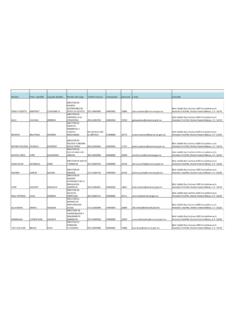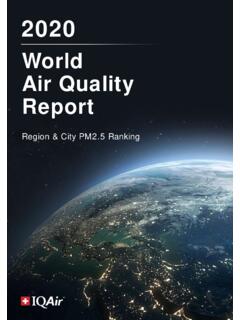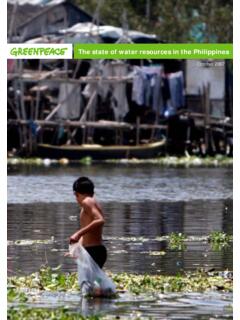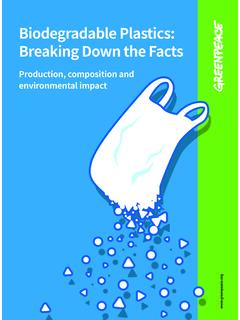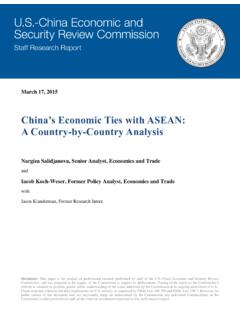Transcription of Ranking the World’s Sulfur Dioxide (SO ) Hotspots: 2019-2020 2
1 Ranking the World s Sulfur Dioxide (SO2) Hotspots: 2019-2020A closer look at the colourless gas that is poisoning our air and health Writers: Sunil Dahiya, Andreas Anh user, Aidan Farrow, Hubert Thieriot, Avinash Chanchal, Lauri Myllyvirta Data analysis and graphs: Hubert Thieriot, Andreas Anh user, Lauri Myllyvirta Project coordinators: Xinyi Shen, Erin Newport, Minwoo Son, Jiyun Choi Contributors: Isabella Suarez, Meglena Antonova, Gokhan Ersoy, Jonathan Moylan, Nhlanhla Sibisi, Pablo Ram rez, Elena Sakirko, Qian Liu, Ahmed El Droubi, Bondan Andriyanu, Denis i ko, Erika Uusivuori Edited by: Kathryn Miller Designed by: Lauren Austin Suggested citation: Dahiya, S., Anh user, A., Farrow, A., Thieriot, H., Kumar, A., & Myllyvirta, L. Global SO 2 emission hotspot database. Delhi: Center for Research on Energy and Clean Air & Greenpeace India . 48 pp. October 2020. Published by: Center for Research on Energy and Clean Air & Greenpeace India Ranking the World s Sulfur Dioxide (SO 2 ) Hotspots: 2019-20201 Executive summary Sulfur Dioxide (SO 2 ) is a colourless air pollutant that is invisible to the human eye, widespread and hazardous to human health.
2 Breathing SO 2 increases the risk of health conditions including stroke, heart disease, asthma, lung cancer and premature death. The single biggest source of SO 2 is from burning fossil fuels, including coal, oil and gas. Dangerous levels of SO 2 pollution are often found near coal-fired power plants, at oil refineries and in areas that are dominated by heavy industry. Report findings For this CREA/Greenpeace report, researchers used satellite data and a global catalogue of 1SO 2 emissions sources from the United States National Aeronautics and Space Administration (NASA) to detect emissions hotspots. The data were analysed to identify source industries and emissions trends. The findings indicate that anthropogenic SO 2 emissions decreased by approximately 6% worldwide in 2019. For only the second time on record, SO 2 emissions decreased in all of the top three countries with the greatest emissions: India, Russia and China. In India, emissions fell for the first time in four years because of a reduction in the use of coal.
3 In 2019, India emitted 21% of global anthropogenic SO 2 emissions, which was nearly twice that of the world s second largest emitter of SO 2 , Russia. The primary reason for India s high emissions is the expansion of coal-based electricity generation over the past two decades. Although China was once the world s biggest emitter of SO 2 , the country s emissions have plummeted by 87% since their 2011 peak, in large part due to strengthened emissions standards and increased use of scrubbers at power plants. In 2019, China s anthropogenic SO 2 emissions fell by 5%, the slowest rate of decrease in the past decade. South Africa also experienced a sharp decline in SO 2 emissions in 2019, bringing the country s SO 2 emissions to their lowest level on record. Further investigations are required to understand the reasons for such reductions. One of the potential factors could be the temporary reduction of coal-fired generation capacity that led to the so-called load shedding that year.
4 By contrast, SO 2 emissions rose by 14% in Turkey in 2019, one of the few countries in which emissions increased in that year. Coal-based energy production remains the major source of SO 2 emissions in Turkey. The Norilsk smelter site in Russia was the biggest source of anthropogenic SO 2 emissions in the world in 2019. The Rabigh oil and gas hotspot in Saudi Arabia ranked second, and Zagroz in Iran ranked third. 1 Within this report, "Greenpeace" refers to Greenpeace India, unless otherwise indicated. Ranking the World s Sulfur Dioxide (SO 2 ) Hotspots: 2019-20202 In Southeast Asia, the largest SO 2 hotspot was the Suralaya coal cluster in Banten, Indonesia, followed closely by Singapore s oil and gas refineries. Although SO 2 concentrations remain dangerously high, global SO 2 levels have continued to fall through 2020, probably because of a reduction in energy demand as a result of the COVID-19 pandemic. The largest reductions were observed in the coal and smelter sectors.
5 In many industrial areas there was a significant drop in the amount of SO 2 detected by satellites. Greenpeace urges governments to halt all investment in fossil fuels and shift to safer, more sustainable energy sources, such as wind and solar. At the same time, there is an urgent need to strengthen emissions standards and apply flue gas pollution control technology at power plants, smelters and other industrial SO 2 emitters. It is encouraging that all three countries with the highest emissions reduced their emissions in 2019, but nonetheless SO 2 pollution continues to threaten the health of billions of people. The single biggest source of SO 2 is fossil fuel combustion. In most cases, new wind and solar technology is cheaper than coal, oil and gas, even before taking the cost of air pollution and climate change into account. The solutions to air pollution are clear and widely available. Governments must prioritise renewable energy, halt investment in fossil fuels, and ensure that every person has access to safe, clean air.
6 Ranking the World s Sulfur Dioxide (SO 2 ) Hotspots: 2019-20203 Contents Contents4 Introduction5 Methodology7 OMI and MEaSUREs SO2 emission catalogue7 Limitations of satellite-based SO2 observations and emission estimates9 Data coverage9 Data uncertainty9 South America: the South Atlantic Anomaly9 Source type reclassification and renaming1 0 Rankings1 1 Interactive pollution map1 1 Concentrations analysis in 20201 2 Results and analysis (NASA MEaSUREs)13 Geographical regions19 India19 Russia21 China22 Saudi Arabia23 Mexico24 South Africa25 Turkey2 6 Europe27 Australia29 Southeast Asia30 Major polluting sectors31 Coal combustion31 Oil and gas refining/ power generation34 Smelters36 2020 trends (OMI Data)37 Regions38 Sectors39 The way forward4 3 Appendix A. Data uncertainty ranges44 Appendix B. power Station Emission Standards47 Ranking the World s Sulfur Dioxide (SO 2 ) Hotspots: 2019-20204 Introduction Harmful substances are emitted when fossil fuels are burned, which has grave impacts on both the climate and public health.
7 Combustion processes release greenhouse gases into 23the air. Each year, an estimated million people die because of exposure to ambient air pollution, and an additional million deaths are caused by indoor and household air pollution according to an estimate by the World Health Organization (WHO) based on 2016 data. Research published in 2020 that applied a refined methodology and updated risk 4factors for different pollutants concluded that fossil fuel combustion alone caused an estimated million premature deaths in the 2019 and is responsible for approximately loss to the GDP globally. 5 Sulfur Dioxide (SO 2 ) is a toxic gas released when materials that contain Sulfur , an element found in all types of coal and oil resources, are burned. The health impacts caused by the pollutant result from both direct exposure to SO 2 as well as exposure to fine particulate matter (PM ), which is produced when SO 2 reacts with other air pollutants. Exposure to 6SO 2 and PM leads to health problems.
8 Acute symptoms following SO 2 exposure include: a burning sensation in the nose, throat and lungs; breathing difficulties; and harm to the respiratory system. Severe, chronic health impacts include: dementia; fertility problems; 78reduced cognitive ability; heart and lung disease; and premature death. Researchers 910estimate that secondary particles (sulfates and nitrates) formed through chemical reactions from precursor gases such as SO 2 and NO x comprise more than 10% of fine particles in China and India, and much more during some heavy pollution episodes. 111213In addition to health impacts, every combustion process that emits SO 2 also releases substantial quantities of greenhouse gases into the atmosphere. Sources of SO 2 thus have a negative direct effect on human health as well as a negative long term impact on human wellbeing through their associated emissions of greenhouse gases, which drives global warming. 2 Ramanathan, V. Climate Change, Air Pollution, and Health: Common Sources, Similar Impacts, and Common Solutions.
9 In: Al-Delaimy W., Ramanathan V., S nchez Sorondo M. (eds) Health of People, Health of Planet and Our Responsibility. Springer, Cham. (2020). 3 Perera, F. Pollution from Fossil-Fuel Combustion is the Leading Environmental Threat to Global Pediatric Health and Equity: Solutions Exist. Int. J. Environ. Res. Public Health 15(1), 16 (2017). 4 Schraufnagel, D. E. et al. Air Pollution and Noncommunicable Diseases: A Review by the Forum of International Respiratory Societies' Environmental Committee, Part 1: The Damaging Effects of Air Pollution. Chest 155(2), 409 416 (2019). 5 Farrow, A., Miller, K. A. & Myllyvirta, L. Toxic air: The price of fossil fuels. Seoul: Greenpeace Southeast Asia. 44 pp. February 2020. 6 Particles with aerodynamic diameter of approximately m. 7 Wu, et al. Association between air pollutants and dementia risk in the elderly. Alzheimers Dement. Amst. Neth . 1(2), 220 228 (2015). 8 Carr , J. et al. Does air pollution play a role in infertility?
10 : A systematic review. Environ. Health 16, 82 (2017). 9 Shehab, & Pope, Effects of short-term exposure to particulate matter air pollution on cognitive performance. Sci. Rep. 9, 8237 (2019). 10 Cohen, A. J. et al. Estimates and 25-year trends of the global burden of disease attributable to ambient air pollution: an analysis of data from the Global Burden of Diseases Study 2015. Lancet 389(10082), 1907 1918 (2017). (17)30505-6 11 Huang, R. J. et al. High secondary aerosol contribution to particulate pollution during haze events in China. Nature , 514(7521), 218 222 (2014). 12 Nagar, et al. Characterization of in Delhi: role and impact of secondary aerosol, burning of biomass, and municipal solid waste and crustal matter. Environ. Sci. Pollut. Res. 24(32), 25179 25189 (2017). 13 Wang, G. et al. Persistent sulfate formation from London Fog to Chinese haze. PNAS USA 113(48), 13630 13635 (2016). Ranking the World s Sulfur Dioxide (SO 2 ) Hotspots: 2019-20205 According to NASA MEaSUREs data catalogue more than two-thirds (68%) of SO 2 emissions have anthropogenic origin.
